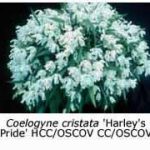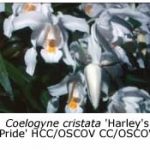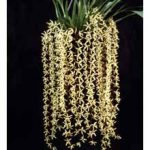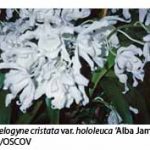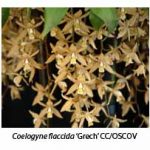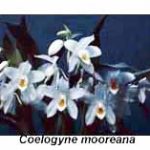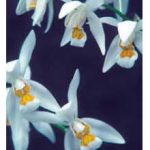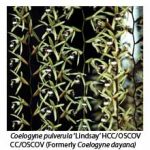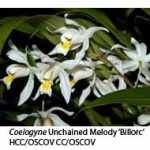Coelogynes have never been a fashionable genus, despite being easy to grow, possibly because of their relatively short-lived flowers. Even the hybridists have largely ignored them, as is emphasised by the low number of registrations. Most growers have the odd basket of C. cristata or C. flaccida hanging at the back of their orchid houses (or under trees in the backyard), which no doubt are admired in early spring when they smother themselves in their fragrant flowers.
The term “Angel Orchid” has been used to describe a couple of the glistening white species, most notably C. cristata. However, not all coelogynes have white flowers. Whilst about half a dozen species are commonly grown, many are a bit harder (but worth the effort) to track down. There are many plants in cultivation with incorrect labels, and some well known names have been relegated to synonymy.
HISTORY. Englishman John Lindley (1799 – 1865) founded the genus Coelogyne in 1821. He subsequently named a large catalogue of species. It is interesting to note that there is no designated type species for this genus, because a number of species were initially described on the same sheet. However, some texts claim that Coelogyne punctulata is the type species. The name Coelogyne comes from the Greek koilos (hollow) and gyne (female), which probably refers to the deeply set stigmatic cavity found in members of the genus.
DISTRIBUTION. Coelogyne is a large genus with around 190 species, many of which are unknown in cultivation. Being of Asian origin, coelogynes are found in Nepal and India east through to China and Malaysia, the Philippines, Indonesia, Papua New Guinea and the Pacific Islands. Surprisingly, there are no Coelogyne species native to Australia, despite its close links with the floras of neighbouring countries. Other genera related to Coelogyne include Chelonistele, Dendrochilum, Panisea, Pholidota and Pleione.
CULTIVATION. Coelogynes are generally plants from mountainous regions, about 80% of the species therefore being suitable for cultivation in cool to intermediate conditions. However there are also species from the monsoonal lowlands. These can be grown outdoors in districts with subtropical and tropical climates but require the luxury of a heated glasshouse (with a minimum temperature of 12°C) in temperate areas.
I have found that most species do well in squat black plastic pots in a standard mix of 80% treated pine bark (medium grade), 10% washed river gravel and 10% perlite. Smaller growing species prefer a finer mix, whilst larger growing species, such as C. pandurata, prefer a coarser medium. Some of the rambling species (such as C. ovalis) can alternatively be mounted on suitable hosts such as Cyathea tree fern, ironbark or hardwood.
Coelogynes come from areas that experience high humidity and unrestricted fresh air circulation, so don’t place your plants in a stagnant corner. These epiphytes and lithophytes respond well to filtered light. Between 50% and 70% shade is ideal. Keep the plants moist while they are growing and flowering. In fact I let the plants dry out only during winter, when most species are in a dormant state. A thorough watering every two weeks should suffice in winter. This dormancy helps to induce flowering and should be respected. C cristata responds to being kept dry (and pretty cold!) in winter by producing a ‘snowstorm’ of angelic white flowers in early spring. I have seen exceptional flowerings of this species in Tasmania and southern Victoria.
I know there is always emphasis placed on minimum winter temperatures, but I believe that keeping the plants cool in summer is just as important. Remember, in their native habitats the mountainous types will seldom experience temperatures over 26°C. A quick misting late in the day during summer will certainly be appreciated.
In the descriptions I have referred to the following temperature zones for cultivation.
Cool Growing: winter minimum of 4°C. Try to keep plants cool in summer.
Intermediate Growing: winter minimum of 8°C, but can take cooler temperatures for short periods.
Warm Growing: winter minimum of 14°C. They are very unforgiving if temperatures fall below 10°C but can withstand high temperatures as long as the relative humidity is high.
A SELECTION OF SPECIES IN CULTIVATION.
Coelogyne asperata Lindley is a large-growing lowland species that requires warm conditions. Widely distributed from Malaysia, the Philippines, Indonesia to Papua New Guinea and the islands of the South-West Pacific. Creamy, fragrant flowers with a colourful labellum are produced in summer.
Coelogyne bilamellata Lindley, from the Philippines, is a rare intermediate-growing species that may flower all year on well-cultivated plants. Small cream-to-caramel flowers are produced singly on long, pendulous inflorescences. Up to 40 flowers per spike is the norm for this quaint successively flowering species.
Coelogyne brachyptera Reichb. f. (once classified as C. parishii var. brachyptera) is an uncommon taxon from Burma and Thailand. It has unusual cigar-shaped pseudo-bulbs. Up to four creamy green flowers with an attractive flared labellum are produced in summer. Prefers intermediate conditions.
Coelogyne chloroptera Reichb. f. is a spring-flowering Philippines species has up to a dozen green flowers on an upright inflorescence. The markings on the labellum are brown and cream. Intermediate to warm conditions.
Coelogyne cristata Lindley. This Himalayan species, arguably the most popular in cultivation, has lovely sprays of up to eight crystalline white, fragrant flowers with orange markings on the labellum. Just as attractive is C. cristata var. lemoniana (named after Sir Charles Lemon), which has yellow markings on its labellum. The pure white form if known as C. cristata var. hololeuca. Flowers produced in early spring. Cool growing.
Coelogyne cumingii Lindley, found in Thailand, Malaysia and Indonesia, is another fragrant white-flowered species that flowers in spring. It’s an intermediate grower.
Coelogyne fimbriata Lindley is a miniature cool-growing species with a huge distribution, from India eastwards to Hong Kong; also found in Malaysia. Resembles C. ovalis. Green flowers with a brown labellum are produced singly or in pairs during autumn.
Coelogyne fragrans Schltr. is an intermediate-growing species from Papua New Guinea. Large green flowers on erect spikes in late spring. Often confused with the related C. beccarii.
Coelogyne flaccida Lindley is a variable cool-growing species from India and Nepal through to China. This early spring-flowered species is familiar to most growers. Most clones have pendulous spikes of up to 14 cream flowers. A larger flowered buff-coloured form in cultivation is worth tracking down. All forms are worth growing for the distinctive perfume alone. Should be in every collection.
Coelogyne flexuosa Rolfe is a robust species from Indonesia and Peninsular Malaysia. Prefers intermediate to warm conditions. Produces a long inflorescence with up to twenty white flowers in late spring. An interesting feature of this taxon is its zig-zag rachis.
Coelogyne fuscescens Lindley is a cool- to intermediate-growing species from India and Nepal. Unusual half-opened, creamy brown flowers are produced in winter, up to five on a short spray. There appear to be two forms of this species in cultivation. The labellum of one form has a deep brown blotch, which is absent in the other.
Coelogyne lactea Reichb. f. is sometimes still seen in collections under the name of C amoena. This species is probably synonymous with C. huettneriana Reichb. f, and has obvious close affinities with C. flaccida, differing mainly in its shorter and thicker inflorescence. Cool-growing with short pendulous spikes of up to eight white flowers in spring.
Coelogyne lawrenceana Rolfe is a warm-to-intermediate growing species from Vietnam, allied to C. speciosa. Uncommon in collections. One to three large brownish-cream flowers are usually produced in spring, but it may also flower in autumn.
Coelogyne lentiginosa Lindley, from Burma, Thailand and Vietnam, is an intermediate-growing species that has cream flowers with an eye-catching, contrasting flared labellum. It flowers in spring and early summer.
Coelogyne merrillii Ames is an intermediate-growing species from the Philippines. Large cream flowers, which often don’t open fully, are produced in small groups during summer.
Coelogyne mooreana Rolfe, the queen of the genus in my opinion, is a rare cool-growing species from Vietnam. Large and well-shaped glistening white flowers are produced on erect to arching inflorescences in late spring. It’s quite easy to grow. The cultivar ‘Brockhurst’ FCC/RHS is the clone most frequently seen.
Coelogyne nitida Lindley is a widespread cool-growing species found from India through to Laos, Thailand and China. It produces erect spikes bearing impressive white flowers with an attractively marked labellum in late spring or early summer. It is well known in many Australian collections as Coelogyne ochracea Lindley.
Coelogyne pandurata Lindley is a robust, warm-growing species from Borneo, the Philippines and Indonesia. Large green flowers with an almost black labellum. Spring to summer flowering. Is often confused with the closely related C. mayeriana Reichb. f.
Coelogyne parishii Hooker, native to Burma and Thailand, is a cool-to-intermediate growing species with flowers that resemble a small version of C. pandurata. Up to five green flowers are produced in spring. Sometimes slow growing.
Coelogyne prolifera Lindley is a cool-growing, rambling species from northern India, Nepal and Burma. Small light greenish-yellow flowers are produced in small clusters in summer. Rarely seen in cultivation, as it is not an attractive species.
Coelogyne pulverula Teijsm. & Binn. is a warm-to-intermediate growing taxon from Malaysia and Indonesia. Long, pendulous inflorescences that carry many flowers are produced in summer. This species was previously well known as C. dayana. The long-lasting flowers are pale yellow with brown markings.
Coelogyne rochussenii De Vries is a scarce species found in Malaysia, Indonesia and the Philippines. Long pendulous inflorescences carry numerous lemon-yellow to light-tan flowers in summer. Responds well to warm conditions.
Coelogyne schultesii Jain & Das. is a rare northern Indian species that prefers intermediate to warm conditions. Orange to brown flowers with an attractive labellum are produced successively from spring to summer. Will become very popular when more plants become available.
Coelogyne speciosa (Blume) Lindley is a variable Malaysian and Indonesian species. Clones can be found in both the lowlands and the mountains, so it is important to link the forms to their cultivation needs. I lean towards the intermediate style of culture. Well-grown plants can be in flower from spring through to late autumn. Plants in heated glasshouses may flower all year. Large brownish flowers are produced on short pendulous inflorescences. A closely related taxon from Sulawesi has long pendant inflorescences that flower sequentially. Coelogyne stricta (D. Don) Schltr. is rarely seen in collections, sometimes under the name C. elata Lindley. A cool-growing species from the Himalayas, it produces erect spikes that carry about a dozen white to cream flowers in spring. The pseudo-bulbs are separated by a long woody rhizome, which makes larger plants difficult to contain in pots.
Coelogyne tomentosa Lindley is an impressive cool-to-intermediate growing species from Malaysia and Indonesia. Produces long pendulous spikes of buff-coloured flowers in spasms from summer to autumn. Previously known in cultivation as C. massangeana (named by Reichenbach in 1878). However, recent studies show that the two are conspecific and thus C. tomentosa, named in 1854, takes priority.
Coelogyne trinervis Lindley is a widely distributed intermediate-growing species found from Burma through Thailand and into Malaysia and Indonesia. Sometimes seen in collections as C. cinnamomea or C. rossiana. Short sprays of buff cream flowers are produced in spring.
Coelogyne usitana Roth & Gruss, first described in 2001, is an impressive warm-growing species endemic to the island of Mindanao in the Philippines. It is closely related to C. celebensis and C. speciosa, producing creamish green blooms with a contrasting dark brown to near black labellum.
Coelogyne virescens Rolfe is a delightful cool-growing species distributed from India to Thailand and Indo-China. Cream to light green- coloured flowers are produced in spring.
Coelogyne viscosa Reichb. f. is a cool-to-intermediate growing plant from India, Burma, Thailand, China, Malaysia and Indonesia. Short upright sprays of creamy white flowers with an orange-yellow labellum are produced in spring. Is synonymous with C. graminifolia and is also frequently seen in collections as C. tomentosa.
Coelogyne xyrekes Ridley is a late summer-flowering species from Malaysia. Very closely related to C. speciosa, it prefers intermediate conditions.
PESTS AND DISEASES. With proper hygiene, coelogynes are generally free of pests and diseases. Caterpillars can do quite a bit of damage to flowers and buds if left unchecked. Neglected plants can often provide homes for mealy bug and scale insects. If plants are kept dry, red spider mite could become a problem, especially when grown with cymbidiums; hosing under the leaves may help control these pests. Aphids can be a nuisance and may stunt developing growths and inflorescences. I am unaware of virus in coelogynes; however, its occurrence would not surprise me.
PROPAGATION. Seedlings are surprisingly scarce, and most coelogynes are divisions of established plants. Divisions of at least three front pseudo-bulbs should be made in spring. Pairs of pseudo-bulbs can be ‘started’ in a coarse cymbidium mix.
Many species look their best when grown as specimen plants in hanging baskets. Suitable plants include C. cristata, C. fimbriata, C. flaccida, C. lactea, C. ovalis, C. pulverula, C. speciosa, C. tomentosa and the hybrid C Unchained Melody. Back-cutting older sections of the plant will produce more growths and this will mean more flowers, because coelogynes flower only off their new growths. However, well grown plants of the sequentially flowering C. bilamellata, C. schultesii and C. speciosa will continue flowering on last season’s growths, whilst flowering off the new.
